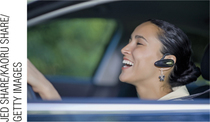EXAMPLE 3.22 Cell Phones and Driving

Does talking on a hands-free cell phone distract drivers? Undergraduate students “drove” in a high-fidelity driving simulator equipped with a hands-free cell phone. The car ahead brakes: how quickly does the subject respond? Twenty students (the control group) simply drove. Another 20 (the experimental group) talked on the cellphone while driving. The simulator gave the same driving conditions to both groups.24
This experimental design has good control because the only difference in the conditions for the two groups is the use of the cell phone. Students are randomized to the two groups, so we satisfy the second principle. Based on past experience with the simulators, the length of the drive and the number of subjects were judged to provide sufficient information to make the comparison. (We learn more about choosing sample sizes for experiments in starting Chapter 7.)